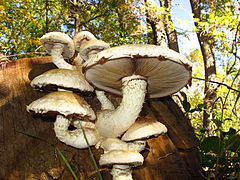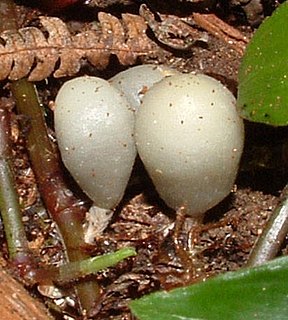
Secotioid fungi are an intermediate growth form between mushroom-like hymenomycetes and closed bag-shaped gasteromycetes, where an evolutionary process of gasteromycetation has started but not run to completion. Secotioid fungi may or may not have opening caps, but in any case they often lack the vertical geotropic orientation of the hymenophore needed to allow the spores to be dispersed by wind, and the basidiospores are not forcibly discharged or otherwise prevented from being dispersed —note—some mycologists do not consider a species to be secotioid unless it has lost ballistospory.

The fungal order Agaricales, also known as gilled mushrooms or euagarics, contains some of the most familiar types of mushrooms. The order has 33 extant families, 413 genera, and over 13,000 described species, along with six extinct genera known only from the fossil record. They range from the ubiquitous common mushroom to the deadly destroying angel and the hallucinogenic fly agaric to the bioluminescent jack-o-lantern mushroom.
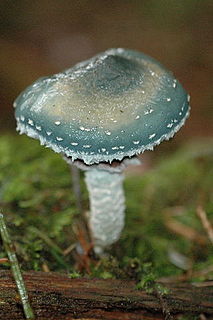
The Strophariaceae are a family of fungi in the order Agaricales. Under an older classification, the family covered 18 genera and 1316 species. The species of Strophariaceae have red-brown to dark brown spore prints, while the spores themselves are smooth and have an apical germ pore. These agarics are also characterized by having a cutis-type pileipellis. Ecologically, all species in this group are saprotrophs, growing on various kinds of decaying organic matter. The family was circumscribed in 1946 by mycologists Rolf Singer and Alexander H. Smith.

The genus Stropharia is a group of medium to large agarics with a distinct membranous ring on the stipe. Well-known members of this genus include the edible Stropharia rugosoannulata and the blue-green verdigris agarics. Stropharia are not generally regarded as good to eat and there are doubts over the edibility of several species. However the species Stropharia rugosoannulata is regarded as prized and delicious when young, and is now the premier mushroom for outdoor bed culture by mycophiles in temperate climates.
Cantharellopsis is a tan- to whitish-colored bryophilous monotypic genus in the Hymenochaetales. The fruit bodies of the single species Cantharellus prescotii has a form intermediate between an Omphalina and a chanterelle (Cantharellus) because of its forked, fold-like gills. It inhabits moss on calcareous soils in temperate regions of Europe. Phylogenetically related agarics are in the genera Contumyces, Gyroflexus, Loreleia, Rickenella and Blasiphalia, as well as the stipitate-stereoid genera Muscinupta and Cotylidia and the clavarioid genus, Alloclavaria.

Cotylidia is a fungal genus characterized by small to moderately sized, white to palely yet brightly colored, stalked, fan-shaped to funnel-shaped fruit bodies with a smooth to wrinkled hymenium, tissues composed of monomitic hyphae, basidia producing smooth, nonamyloid spores, the absence of clamp connections, and bearing projecting cylindrical, thin-walled, hymenial cystidia. The genus is classified in the Hymenochaetales, however the type species, C. undulata has not yet been sequenced. Phylogenetically-related agaricoid fungi to the two species of Cotylidia thus far sequenced are in the genera Rickenella, Contumyces, Gyroflexus, Loreleia, Cantharellopsis and Blasiphalia, and Muscinupta and the clavarioid genus, Alloclavaria.
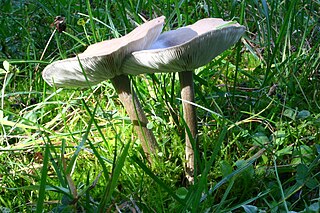
Melanoleuca is a poorly known genus of saprotrophic mushrooms traditionally classified in the family Tricholomataceae. Most are small to medium sized, white, brown, ocher or gray with a cylindrical to subcylindrical stipe and white to pale yellowish gills. The basidiospores are ellipsoid and ornamented with amyloid warts. Melanoleuca is considered a difficult group to study due to their macroscopic similarities among species and the need of a thorough microscopic analysis to separate species. DNA studies have determined that this genus is closely related to Amanita and Pluteus and that it does not belong to the family Tricholomataceae.
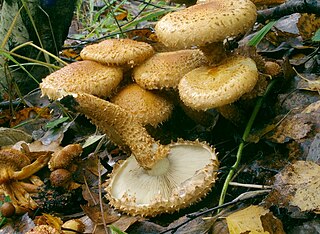
Pholiota is a genus of small to medium-sized, fleshy mushrooms in the family Strophariaceae. They are saprobes that typically live on wood. The genus has a widespread distribution, especially in temperate regions, and contains about 150 species.

The Physalacriaceae are a family of fungi in the order Agaricales. Species in the family have a widespread distribution, ranging from the Arctic, (Rhizomarasmius), to the tropics, e.g. Gloiocephala, and from marine sites (Mycaureola) and fresh waters (Gloiocephala) to semiarid forests (Xerula).

The Inocybaceae are a family of fungi in the order Agaricales. Members of this family have a widespread distribution in tropical and temperate areas.
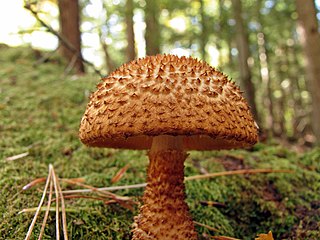
Leucopholiota decorosa is a species of fungus in the mushroom family Tricholomataceae. Commonly known as the decorated pholiota, it is distinguished by its fruit body which is covered with pointed brown, curved scales on the cap and stem, and by its white gills. Found in the eastern United States, France, and Pakistan, it is saprobic, growing on the decaying wood of hardwood trees. L. decorosa was first described by American mycologist Charles Horton Peck as Agaricus decorosus in 1873, and the species has been transferred to several genera in its history, including Tricholoma, Tricholomopsis, Armillaria, and Floccularia. Three American mycologists considered the species unique enough to warrant its own genus, and transferred it into the new genus Leucopholiota in a 1996 publication. Lookalike species with similar colors and scaly fruit bodies include Pholiota squarrosoides, Phaeomarasmius erinaceellus, and Leucopholiota lignicola. L. decorosa is considered an edible mushroom.

Panellus is a genus of more than 50 mushroom species of fungi in the family Mycenaceae as defined molecularly. Prior to molecular analyses the generic name had been used for any white-spored pleurotoid with amyloid spores. Unrelated but similar species are now classified in Sarcomyxa and Scytinotus. In older guides and other literature the type species had been placed in either Pleurotus or Panus and the poroid species had been classified in the synonymous genus Dictyopanus or in broadly defined genera like Polyporus (Polyporaceae) or the more closely allied Favolaschia (Mycenaceae). The closest molecular allies are Resinomycena and Cruentomycena.
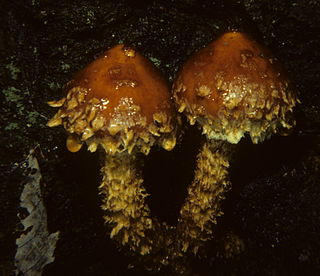
Hemistropharia is a genus of agarics of unclear classification, though possibly related to the Hymenogastraceae or Tubarieae. A monotypic genus, it contains the single species Hemistropharia albocrenulata. This species, originally named Agaricus albocrenulatus by American mycologist Charles Horton Peck in 1873, is synonymous with the names Pholiota albocrenulata (Peck) Sacc. and Stropharia albocrenulata (Peck) Kreisel, among others. The genus most closely resembles a typical Pholiota where it was previously classified and described and it causes a decay in trees as does a true Pholiota. Unlike Pholiota, Hemistropharia albocrenulata lacks chrysocystidia, and it has darker basidiospores.

Protostropharia, is a coprophilous agaric fungal genus that produces glutinous, mostly yellowish to yellow brown fruit bodies. Characteristically most form chrysocystidia and rather large, smooth, violaceous basidiospores each with a prominent germ pore. It is differentiated from Stropharia by production of astrocystidia on its mycelium rather than by acanthocytes that Stropharia produces. Phylogenetically, Protostropharia is distinct from Stropharia, Pholiota, and Leratiomyces. Two species, P. luteonitens and P. tuberosa, form pseudosclerotia in the dung substrates.
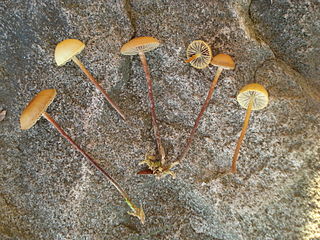
Bogbodia is a bog-inhabiting agaric fungal genus that colonizes peat and Sphagnum and produces tan-colored fruit bodies. The only species in the genus is Bogbodia uda. Characteristically it forms chrysocystidia and rather large, finely roughened, violaceous basidiospores each with a poorly defined germ pore. The genus differs from Hypholoma which has smaller, smooth basidiospores and typically have cespitose fruit bodies and decay wood. Phylogenetically, Bogbodia is distinct from Hypholoma, Pholiota, and Leratiomyces.
Stagnicola is an agaric fungal genus that contains the single species Stagnicola perplexa. This fungus colonizes plant debris in wet coniferous forest floor depressions and shallow pools, and fruits after the pools drain or dry in late summer to early fall in North America and Europe. The genus is characterized by smooth, yellowish brown basidiospores lacking a germ pore, and a naucorioid appearance, with brownish mycelium at the base of the stems. Phylogenetically, Stagnicola appeared rather isolated and proved to be closest to Mythicomyces and Mythicomyces was closest to the Psathyrellaceae. In 2019 the two genera were shown to be closely related and placed in a new family, Mythicomycetaceae sister to the Psathyrellaceae.
Flammula is a dark brown-spored genus of mushrooms that cause a decay of trees, on whose bases they often fruit, forming clusters of yellowish brown mushrooms.
Phaeonematoloma is a small genus of slender, fleshy mushrooms in the family Strophariaceae with large, brownish spores with a germ pore and with conspicuous chrysocystidia. The genus has several assigned species but may be monotypic. The type species, Phaeonematoloma myosotis, grows along the edges of bogs in peaty soils and sometimes amongst Sphagnum or other mosses. This type species has been classified in Pholiota, Flammula, and in Hypholoma or the latter's synonymous generic name, Nematoloma, from which the generic name Phaeonematoloma is derived. Unlike Hypholoma (Nematoloma), Phaeonematoloma was originally partially differentiated by its brown spore print without the purplish colors of a "Nematoloma". Modern molecular evidence supports the recognition of Phaeonematoloma as an independent genus separate from Hypholoma and Pholiota. It is possible that other species may belong in this genus, which may include Bogbodia.

Meottomyces is a small genus of relatively nondescript, fleshy, brown mushrooms related to Tubaria. In older classifications it had been included in Pholiota, Phaeogalera or Hemipholiota. Modern molecular evidence suggested recognition of a separate genus when sequences of a collection first identified as Pholiota oedipus, now reclassified in Meottomyces, revealed a unique branch. Subsequently, that species was studied by Holec and later as Phaeogalera oedipus was shown to be distinct from Tubaria but not the type of Phaeogalera itself. Additional phylogenetic support was provided by Gitte Petersen and others, who clearly showed a separation from Phaeogalera. The genus was erected by Vizzini for two species and two varieties, all former members of Pholiota. Vizzini treated the name Pholiota oedipus as a misapplied name, but this is contested by Legon who provided detailed notes on the types and ecology of the type species.
Phaeogalera is a small genus of slender, fleshy bog and swamp-inhabiting mushrooms with large, brownish spores with a germ pore and a hymenium lacking chrysocystidia. Phaeogalera resemble Galerina in their habitat, macroscopic appearance, and spore print color, however, their microscopic characteristics more closely resemble Psilocybe. The type species, Phaeogalera stagnina, has an Arctic-alpine distribution in the Northern Hemisphere extending into the boreal forests and taiga. It grows along the edges of bogs in peaty soils and sometimes amongst Sphagnum or other mosses. This type species has been classified in Galerina, Tubaria and Psilocybe. Modern molecular evidence supports the recognition of Phaeogalera as an independent genus separate from Galerina. The generic name is built upon the antiquated generic name "Galera", now synonymous with Galerina, and with a reference to the darker colors of the basidiospores of Phaeogalera. When originally proposed by Kühner, he forgot to fully cite the original publication for the type species which explains by the name was later validly published by Pegler & Young in 1975. The genus Meottomyces was segregated from Phaeogalera after briefly being classified together by Romagnesi.
